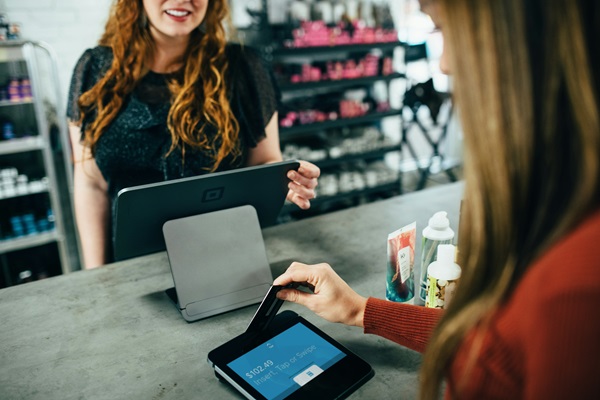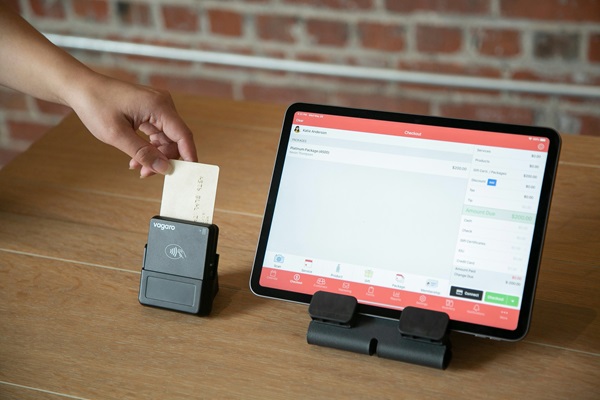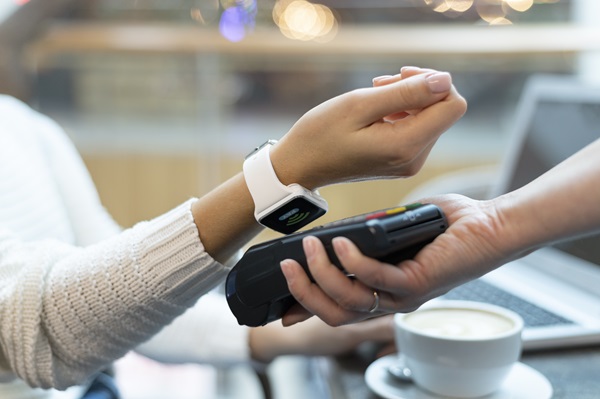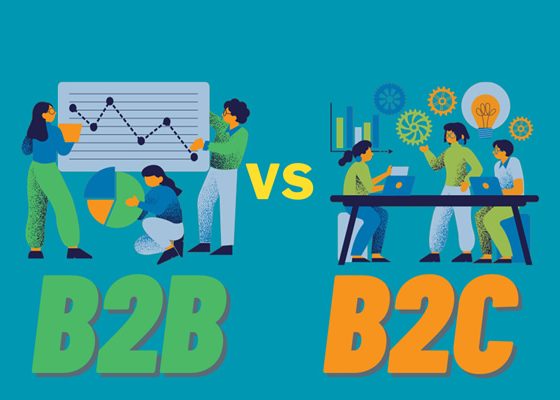Technology is evolving at an unprecedented pace, so it’s no surprise that the way we make payments is changing too. The traditional methods of exchanging cash or swiping a credit card are now sharing the stage with an array of innovative payment solutions. This transformation is not just about convenience; it’s about elevating the customer checkout experience to new heights.

The Rise of Contactless Payments
Imagine making a payment with a simple tap of your card or the wave of your smartphone. The rise of contactless payments has reshaped the landscape of modern transactions. Near-field communication (NFC) technology, which allows data to be transmitted between devices with a simple touch, has paved the way for contactless payments. This technology enables us to make payments swiftly, securely, and without physical contact, making it a game-changer in a world where hygiene and speed are paramount.
Mobile wallets, such as Apple Pay and Google Pay, have taken the concept of contactless payments even further. These virtual wallets store your credit card information, allowing you to pay by simply holding your smartphone near a card reader. The result? A seamless and efficient payment process that enhances the overall shopping experience.
However, the benefits of contactless payments extend beyond mere convenience. They’re also more secure, as they often require biometric authentication, such as fingerprint or facial recognition, to authorize transactions. These layers of security provide customers with peace of mind and are gradually rendering the traditional PIN or signature obsolete.
Biometric Authentication in Payments
Speaking of security, biometric authentication is another innovative payment solution that’s making payments more secure and convenient. Fingerprint scanning, an established feature on most modern smartphones, allows you to authorize payments with a simple touch. This biometric data is unique to you, making it an incredibly secure method of payment verification.
Facial recognition takes this a step further. Your phone’s camera can now identify your face with remarkable accuracy, making transactions a breeze. Voice recognition, while still emerging, offers an additional layer of security, as it identifies you based on your unique vocal patterns.
These biometric methods not only enhance the checkout experience but also deter fraud and identity theft, giving customers even more reasons to embrace innovative payment solutions.
The Role of Cryptocurrencies in Payments
Cryptocurrencies, such as Bitcoin and Ethereum, have been a hot topic in recent years. But how do they fit into the world of payments? The answer lies in blockchain technology, the decentralized ledger that underpins cryptocurrencies. Blockchain ensures the security and transparency of transactions, making it an attractive innovative payment solution
Cryptocurrency wallets serve as your digital vault for storing and managing your digital coins. They come in various forms, from software wallets that run on your device to hardware wallets that provide an extra layer of security by keeping your assets offline.
However, while cryptocurrencies offer unparalleled security and the potential for global transactions, concerns about their volatility and regulatory issues linger. For now, they remain a niche innovative payment solution, but they could very well shape the future of commerce.
QR Code Payment Systems
Quick Response (QR) codes have become ubiquitous in the world of payments. Scanning a QR code with your smartphone is a quick and contactless way to complete a transaction. This method is especially popular in Asia, where it has revolutionized the way people pay for goods and services.
Businesses are increasingly adopting QR code payment apps to streamline the checkout process. Whether you’re at a local coffee shop or a global retail chain, QR codes make payments easy and efficient.
As QR code technology continues to evolve, we can expect even more innovative applications in the future. It’s a prime example of how a simple concept can have a profound impact on the customer checkout experience.
Artificial Intelligence and Personalization
Artificial Intelligence (AI) is not just about robots and self-driving cars; it’s transforming the way we shop and pay. Predictive analytics, powered by AI, analyze your shopping habits and preferences to provide customized checkout recommendations. This technology understands your needs better than you do, enhancing your shopping experience.
AI-driven customer support is also on the rise. Chatbots, powered by natural language processing and machine learning, can answer customer queries, solve problems, and provide personalized assistance in real time. This level of customer support sets a new standard for the checkout experience.
As AI continues to learn and adapt, it’s set to become an integral part of the payment landscape, creating a more efficient, personalized, and engaging shopping journey.
IoT and Seamless Payment Integration
The Internet of Things (IoT) is connecting our world in ways we never imagined. In payments, it’s all about the integration of smart devices. Picture this: your refrigerator detects that you’re running low on milk and adds it to your shopping list. When you’re ready to check out, your IoT-enabled fridge seamlessly integrates with your payment system to finalize the purchase. It’s the future of convenience.
IoT is not limited to our homes. It extends to retail environments, where smart shelves, carts, and kiosks create a more streamlined and efficient shopping experience. By connecting devices and systems, the checkout process becomes faster and more straightforward.
Payment Aggregators and Marketplaces
If you’ve ever shopped on a multi-vendor platform like Amazon, you’ve witnessed the power of payment aggregators. These platforms centralize payment methods, making it easy for customers to shop from different sellers using a single account. This simplification streamlines the checkout process, offering both convenience and flexibility.
For merchants, payment aggregators provide a range of benefits, from fraud prevention to reduced operational complexity. This win-win scenario is reshaping the payment industry by making transactions smoother and more secure.

Subscription Payment Models
The subscription economy is booming. From streaming services to meal kits, customers are increasingly favoring subscription-based products and services. It’s not just convenient; it’s also a reliable revenue model for businesses.
Customers benefit from the predictability of recurring payments, while businesses enjoy higher customer retention rates. Subscription billing platforms make it easy for companies to manage and scale their subscription services, ultimately creating a frictionless checkout experience for subscribers.
Instant Payments and Real-Time Settlements
In a world where instant gratification is the norm, it’s no surprise that instant payments are gaining traction. Traditional transactions involve waiting for authorization and settlement, which can take days. Instant payments, on the other hand, offer real-time transaction processing. Whether you’re sending money to a friend or making a business payment, the funds move immediately.
This innovative payment solution isn’t just about speed; it’s about global access. Instant payments are breaking down borders and enabling cross-border transactions without the usual delays and fees.
Customer Data Security and Privacy
With great innovation comes great responsibility. As innovative payment solutions evolve, so do the risks associated with customer data. Compliance with data protection regulations, such as GDPR, is paramount. Tokenization, the process of substituting sensitive information with a non-sensitive equivalent, is becoming the standard for securing payment data.
The payment industry is in a constant battle against cyber threats, and robust security measures are essential to protect customers and their financial information. Balancing convenience and security is the key to a successful checkout experience.
User-Friendly Payment User Interface
The days of tedious, time-consuming checkout forms are fading. Innovative payment solutions are simplifying the user interface, offering one-click payments that expedite the checkout process. These user-friendly interfaces minimize friction, resulting in an efficient and enjoyable shopping experience.
User experience testing plays a crucial role in refining these interfaces, ensuring that customers can complete transactions effortlessly. The more straightforward the process, the more likely customers are to return.
Payment Integration for E-commerce
E-commerce is booming, and a seamless payment experience is crucial for online retailers. E-commerce payment gateways enable secure online transactions, supporting a wide range of payment methods and currencies. The key is conversion rate optimization, ensuring that as many visitors as possible complete their purchases.
To stay competitive in the e-commerce landscape, businesses must invest in top-notch innovative payment solution that fosters trust, security, and ease of use.
Social Commerce and Peer-to-Peer Payments
Social media is not just about connecting with friends; it’s also becoming a marketplace for buying and selling. Social commerce allows users to shop directly on platforms like Instagram and Facebook, blurring the line between social interaction and retail.
Additionally, peer-to-peer (P2P) payment apps have made it effortless to split bills with friends or send money to family. These apps simplify financial transactions, making them feel more like a conversation than a payment.
The convergence of social and payments is creating exciting new possibilities for businesses and customers alike.
The Role of Big Data in Payment Processing
Behind the scenes, big data is revolutionizing payment processing. Data analytics help businesses understand customer behavior and preferences, enabling them to tailor offers and services. Fraud detection algorithms scour vast datasets to identify and prevent suspicious transactions, safeguarding customers’ financial assets.
Moreover, big data insights provide businesses with valuable market information, helping them stay competitive and responsive to evolving customer demands.
The Future of Wearable Payments
Wearable technology, like smartwatches, is not just for tracking your steps. It’s also becoming a payment tool. With secure payment options embedded in these devices, you can make transactions with a simple flick of the wrist. The convenience and security of wearable payments are setting a new standard for the future of checkout experiences.
IoT wearables are also on the horizon. Imagine seamlessly paying for your groceries by scanning your wristband at the store’s exit. This fusion of technology and payments is changing the way we interact with the world around us.

Payment Innovation in Emerging Markets
While many innovative payment solutions are associated with developed nations, emerging markets are also witnessing rapid changes. Mobile banking provides financial access to underserved populations, empowering individuals to manage their money conveniently.
Financial inclusion is the buzzword in these regions, as people who were previously excluded from formal financial systems can now participate in the global economy. These developments bring both challenges and opportunities to the table.
Sustainability in Payments
In today’s eco-conscious world, sustainability is a significant consideration in innovative payment solutions. Eco-friendly payment methods, like digital receipts and contactless payments, reduce paper waste and the carbon footprint of transactions. Ethical consumerism is on the rise, and consumers are increasingly choosing businesses that align with their values.
The payment industry is taking steps toward a greener future, recognizing the importance of environmental responsibility.
Cross-Channel Payment Experiences
Consumers today don’t shop through a single channel; they explore multiple avenues, from physical stores to online marketplaces. A seamless transition between these channels is essential. Omnichannel strategies ensure that customers receive a consistent experience across all touchpoints, fostering customer loyalty.
When customers can switch between online and offline channels with ease, it creates a positive and memorable shopping journey, increasing their likelihood to return.
Legal and Regulatory Implications
The world of payments doesn’t operate in a legal vacuum. Compliance requirements, such as GDPR, PCI DSS, and various other industry regulations, shape the way businesses handle customer data and financial transactions. These regulations vary from one country to another, adding complexity to the payment landscape.
Global versus local laws further complicate the picture. Companies must navigate the intricate web of regulations to offer seamless payment experiences while adhering to legal standards.
Case Studies: Successful Implementation
The best way to understand the impact of innovative payment solutions is to look at successful case studies. Companies like Apple, Amazon, and PayPal have revolutionized the checkout experience through innovative technologies and strategies. By examining their journeys and learning from their experiences, we can gain insights into what works and how to measure success in the ever-evolving world of payments.
Challenges and Risks in Innovative Payment Solutions
Despite the many advantages of innovative payment solutions, there are inherent risks. Security threats, including data breaches and cyberattacks, remain an ever-present challenge. Customer adoption is another hurdle, as not all customers readily embrace new payment methods. Scalability issues can also be problematic, especially for smaller businesses.
Navigating these challenges is vital for the successful integration of innovative payment solutions.
User Education and Awareness
Adapting to new payment methods can be daunting for many consumers. Educating users on these innovations is crucial for their widespread adoption. Providing training, resources, and clear instructions can make all the difference in how quickly customers adopt and feel comfortable with new payment solutions. Changing consumer behavior is a gradual process that requires commitment from businesses and payment providers.
The Competitive Advantage of Innovation
In a competitive marketplace, businesses that embrace innovative payment solutions have a distinct advantage. They can stay ahead of the curve, differentiating themselves from competitors by offering a superior checkout experience. This approach leads to increased customer loyalty, higher conversion rates, and sustainable growth.
Conclusion
In the dynamic world of payments, innovation is the driving force behind the enhancement of the customer checkout experience. By adopting and adapting to these groundbreaking technologies and strategies, businesses and consumers can shape the future of commerce. Meeting and exceeding customer expectations, and maintaining a commitment to continuous innovative payment solutions, is key to creating a seamless and engaging checkout experience.





